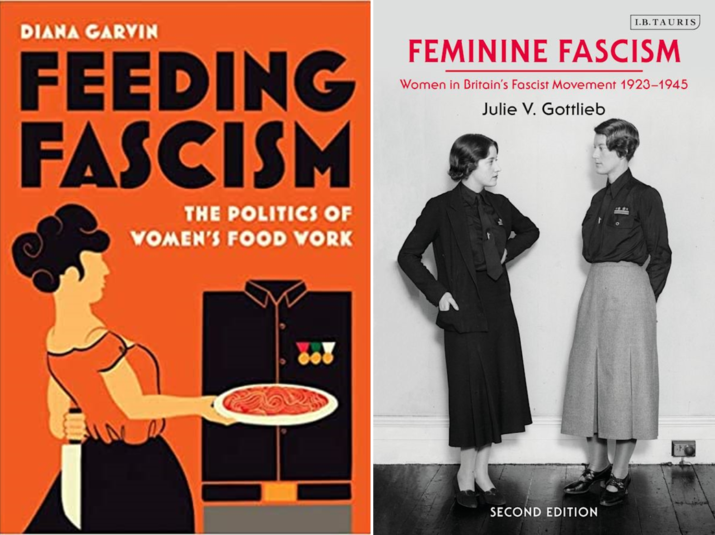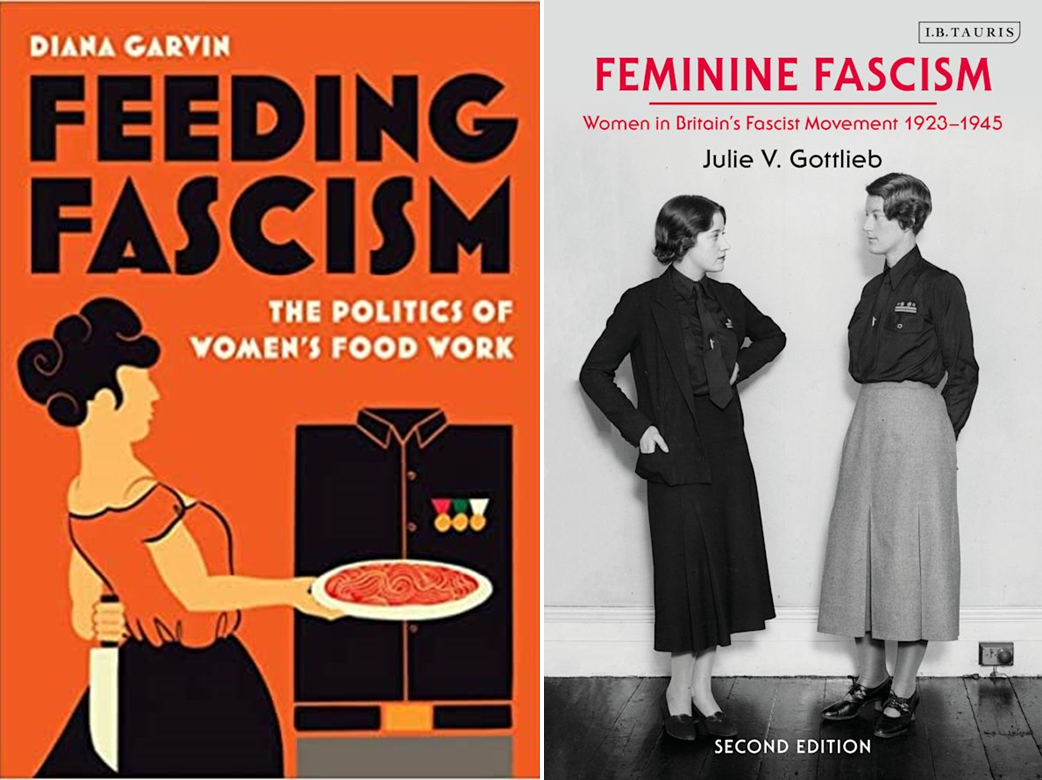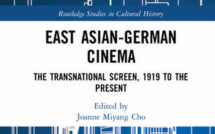
Feminine Fascism: Women in Britain’s Fascist Movement, 1923-1945 by Julie V. Gottlieb and Feeding Fascism: The Politics of Women’s Food Work by Diana Garvin

The exploration of consent and complicity under fascism has intrigued historians of gender and sexuality for decades. Julie V. Gottlieb’s Feminine Fascism: Women in Britain’s Fascist Movement, 1923-1945 (2021), now in its second print edition (originally published in 2000), and Diana Garvin’s Feeding Fascism: The Politics of Women’s Food Work (2022) illustrate the breadth of this methodological inquiry. In each national case study—Great Britain for Gottlieb and Italy for Garvin—the respective authors present an enriching discussion about the contradictions that unfold in dictatorial rule and the experiences of women who are subject to it. Gottlieb and Garvin examine different archives, both in terms of the countries under study and the source material. While Gottlieb illustrates the history of women’s recruitment in the local branches of the British Union of Fascists (BUF), Garvin analyzes a range of sources—from women’s diary entries to company records—to investigate how women’s reproductive capacities became a means of connecting the Italian race (la razza) to the land. What these monographs provide is an enhanced image of fascism’s layers of soft power and coercion, layers that can at times preclude historians from fully visualizing what fascist imperialism looked like at home. Moreover, Gottlieb and Garvin offer two different ways of understanding the extent to which fascism relied upon particular constructions of femininity.
In Feminine Fascism, Gottlieb examines the BUF from its inception in 1923—it was then called the British Fascisti and was under the leadership of Rotha Lintorn-Orman—and traces the group’s evolution under the leadership of Lord Oswald Mosley. Gottlieb makes two main claims: (1) studying women’s participation in British fascism is especially helpful to integrate British history into European studies; and (2) there is a pervasive historical amnesia over the fact that sometimes women were not victims of fascism but were among its most ardent supporters. Based on oral histories, group meeting minutes, and records of local associations’ activities, Gottlieb argues that historians have erased the lives of women who saw advantages and benefits in supporting the fascist corporate state (5). Paradoxically, while these women did, in fact, support fascism, many also expressed fear that they, too, might become second-class citizens under the dictatorship they supported. Often, women who participated in the movement in various capacities—from attending leadership meetings to training in jiu-jitsu—worried about the BUF gutting its paid positions and purging party members throughout the 1930s (25, 72). We can further expand Gottlieb’s argument to show that one can be both a victim and supporter of fascism; these positions are not mutually exclusive but rather reflect a strategy in the face of fascism.
Gottlieb clearly demonstrates that subtle changes in group politics pushed fascist leaders to rely increasingly upon women’s participation in the movement. Generally, large demographic shifts in the interwar period provoked jingoist sentiments at the same time as they led to British women’s enfranchisement (27-28). The connection between nationalism and the advancement of women’s rights, however, was not without many issues: fascism was still considered to be imported from Italy; therefore, Gottlieb argues that fascist propaganda needed a more domestic image to properly integrate itself into British society (13). To accomplish this task, BUF women wrote prolifically about the responsibilities they held compared to their young male fascist allies, who seemed to care more about party politics than about claiming their role as future fathers in nuclear families. As Gottlieb asks, “Can patriarchy exist where fathers have been rendered impotent?” (113). Pro-fascist British women therefore sought to fulfill their feminine roles by organizing their own ranks.
In Feeding Fascism, Garvin examines women’s roles as both producers and consumers in the regime’s food landscape. Rather than looking to party politics, as Gottlieb does, Garvin focuses on the everyday. In Gottlieb’s monograph, the term “feminine fascism” refers to the ambiguous position of women as “orators” in the BUF; Garvin interrogates how women became subjects of a feminine “alimentary autarky” (160), which was a form of national self-sufficiency that aimed to nurture the Italian race through mass production. For Garvin, the process of autarky was innocuous; it was found in the banal ways in which publishers, companies, and authors all attempted to modify cookbook recipes to adapt their cuisine to the regime’s biopolitical vision. In fact, Garvin even suggests that dictator Benito Mussolini may have been inspired by the chocolate entrepreneur Luisa Spagnoli when writing his 1927 pro-natalist Ascension Day speech (117). In running his factory, Spagnoli had taken an authoritarian approach, Taylorizing the production of chocolate and creating efficient schedules for workers. Women with children, for example, could use back rooms on the shop floor to breastfeed. As Garvin writes, “Perhaps Benito Mussolini’s visit to the Perugina factory in 1923 provided early inspiration for the regime’s later attempts to rationalize maternal healthcare” (117). Whether there is causation here or mere speculation, what this case study brings forward is a new subjective position for understanding fascism’s biopolitics; that is, women spearheaded many initiatives, and private companies played an integral role in the corporatist fashioning of the state.
Feeding Fascism’s organizational structure is a useful model for navigating the moving parts of fascism’s biopolitical agenda, which is a difficult feat. However, Garvin deftly strikes a balance between explaining the process of food distribution and describing the subjective experiences of women within the macroeconomic transformations that concerned food production at the time. Through a series of case studies, Garvin identifies the contradictions that emerged between women’s experiences under fascism and the ways in which these same women were depicted in the propaganda. For instance, Garvin observes that the mondine (female rice weeders) were presented in unrealistic terms by the regime as happy, oblivious workers through the surprising use of photo-collages on propaganda posters. On these posters, the mondine were juxtaposed with cut-outs of fascist officials, a mediation technique that produced a “false image of consent” by suggesting that the destitute mondine explicitly supported the fascist regime (61). It is only by combining an analysis of food distribution patterns with that of women’s experiences that Garvin convincingly defines alimentary autarky as a dialectical process that relied upon women’s laboring bodies at the same time as it distorted their images to justify the regime’s power over the poor and working class.
Garvin is also critical of longstanding debates that center on whether or not fascist ideology successfully transposed itself onto the institutions it governed. For her, this institution-versus-ideology approach cannot adequately explain how fascist historical actors managed women’s bodies in multifold ways (6-7). Using alternative methodologies, she hopes to encourage new scholarship and offers a refreshing archival postface to the reader, which future scholars of fascism and the postwar will find useful. Notwithstanding the importance of state archives, Garvin encourages scholars to seek out more marginal archives. Indeed, Garvin analyzes women farmers’ experiences, the artifacts these women kept, and the satirical songs they shared about their common hunger through evidence she obtained from company records—for example, Barilla’s—and the Bologna National Diary Archive.
One of many essential differences between Gottlieb’s and Garvin’s respective monographs is their geopolitical perspective, which influences how they approach their subjects’ gender and sexuality. Gottlieb chooses to study the recruitment strategies and political life of the densely insular world of the BUF, where women held surprisingly crucial roles. Garvin instead attends to how food distribution patterns mobilized women. The different scales used bring both opportunities and drawbacks. Gottlieb does not need to explore macro-level shifts, on which Garvin focuses, and instead illuminates the issues of intimacy and relationality among women fascists, an aspect that Garvin’s study cannot address, since the latter analyzes women’s relationships to childrearing. In her analysis of these women’s female intimacies, Gottlieb reveals that they were strategically recruited as daughter-mother duos and that the British Fascisti sometimes came under attack over problems of gender and sexual non-conformity (73). The leader of that group, Lintorn-Orman, for example, was described as a “mannish woman,” and the BUF ranks took to denigrating any protesting “red cowards” who appeared at Blackshirt meetings as “she-males” (16, 119). In fact, these fears over deviant gender roles and sexual acts deeply animated the BUF’s recruits to forge endless images of heterosexual conformity to justify that they were politically necessary to the fascist movement.
By focusing on the politicization of gendered and sexual norms within the BUF, Gottlieb shows that at times “feminine fascism” remained an ambiguous weapon in the BUF’s arsenal. On the one hand, the women’s branch strongly supported dictatorial rule yet found it oppressive when leveled within the BUF’s internal dynamics. Fascist women were supposed to represent ideal women who complemented men allies and provided an image of domesticity; however, many BUF women also engaged in militant and conventionally masculine party activities. Feminine fascism is therefore both a flexible and confounding category of analysis to understand the BUF because BUF members did not always correspond to the idealization of femininity.
For Gottlieb and Garvin, fascism is not, and can never be, the inspiration for feminist praxis, despite the fact that women rose within its ranks. As Gottlieb claims, fascist women considered feminism to be associated with liberal cosmopolitan decadence, which did not support their goal of gender complementarity (2). In these monographs, women are featured as both consumers and producers of their own fertility and gender expression, and the books conclude that women’s participation constituted a driving force in fascist biopolitics. Perhaps what future scholarship may continue to unpack, as Garvin analyzes through food consumption, is how fascist mechanisms of control not only propelled women to support the regime but handed them the tools to administer these patriarchal structures onto themselves and other women. Both authors suggest that there is an incredible amount of historical work to be done in order to understand how gender ideology has shaped fascism.[1]
Lucas René Ramos is a doctoral candidate in Modern European History at Columbia University. His dissertation analyzes religious life, biopolitics, and sexual non-conformity in the making of Italy’s postwar Republic.
Feminine Fascism: Women in Britain’s Fascist Movement, 1923-1945
By Julie V. Gottlieb
Publisher: Bloomsbury Publishing
Soft Cover / 402 pages / 2021
ISBN: 9780755627325
Feeding Fascism: The Politics of Women’s Food Work
By Diana Garvin
Publisher: University of Toronto Press
Hardcover / 276 pages / 2022
ISBN: 9781487528188
[1] See, for example, Molly Tambor. “The origins of the Polizia Femminile, 1948–1961.” Journal of Modern Italian Studies 27, no. 2 (2022): 178-199.
Published on February 21, 2023.




